I followed one of the world's most poisonous types of fish from the seafood market to a roadside stall in the Philippines, where it's turned into a $1.80 delicacy that's surprisingly addictive
Marielle Descalsota

- Puffers, one of the most poisonous types of fish in the world, are a delicacy in Cebu, Philippines.
- I visited the Pasil Fish Market in the middle of the night to see how they're prepared for sale.
Puffer is one of the most poisonous types of fish in the world. But in some parts of the Philippines, it's eaten as a delicacy.
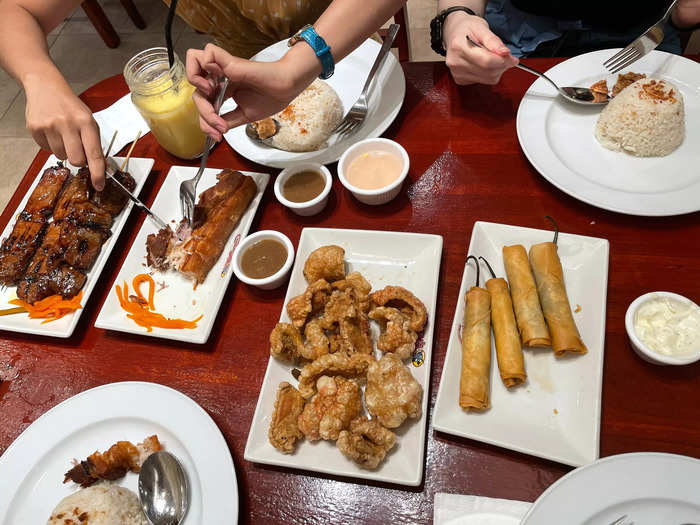
I was raised by Filipino parents, and even though I grew up overseas, I was exposed to a lot of the country's cuisine and flavors throughout my childhood. However, one dish that never made it onto our dinner table was pufferfish.
Ingredients vary widely across the Philippines' more than 7,000 islands, and being of Tagalog and Illonggo descent, my family stuck to more commonly eaten meats, like chicken, beef, and pork.
Even after traveling around the Philippines extensively, I hadn't heard of this poisonous fish that's often turned into meals, until recently, when planning a trip.
After reading that pufferfish stew is a popular dish in the neighborhood I would be visiting in Cebu, an island province in central Philippines, I was determined to try it for myself.
I flew to Pasil, Cebu, in late June to spend a night at the fish market where it's sold, a day watching it be prepared at a restaurant, and finally a meal, sampling this new plate of Filipino cuisine for myself.
I arrived at the fish market in the heart of Cebu just before midnight.
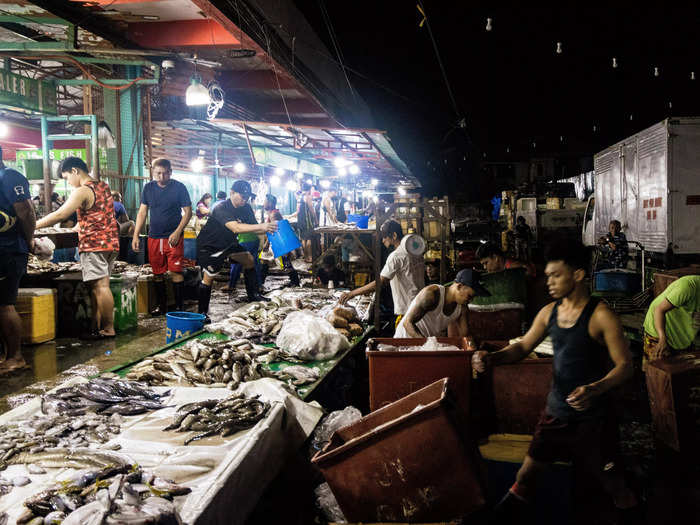
Every night, hundreds of people travel to Pasil Fish Market to buy and sell all kinds of seafood — including buckets of spiky, grey fish collectively known as puffers.
The Pasil Fish Market is the largest seafood market in Cebu. It opened more than 100 years ago, and it's located right outside the largest informal settlement in Cebu. Unlike New York's Fulton Fish Market or Tsukiji in Tokyo, Pasil Fish Market is not a common tourist attraction.
Hundreds of pounds of fish are sold at the market every night, and historically, even sharks and stingrays were sold here. But today, pufferfish is among the most popular.
I was accompanied by two Cebu residents, Nash and Dodong. When I arrived, the neighborhood was almost pitch dark, except for the market.
Puffers caught by fishermen on the coast of Cebu were being cleaned and sold off at the market.
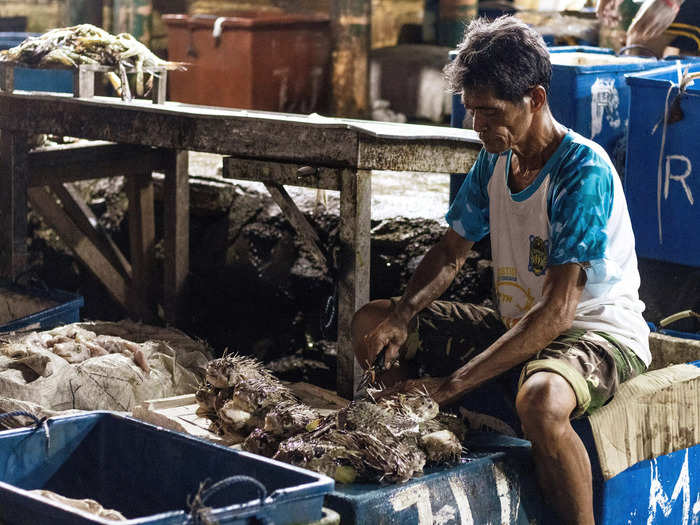
My local guide, Dodong, introduced me to several people working in the market. One of the workers told me that trade here is held only at night and lasts until the wee hours of the morning.
I noticed a man sitting astride a crate brimming with pufferfish. The puffers had brownish-black flecks and dots on their spiky skin, but it was the googly eyes that really set them apart from the other fish in the market.
The man bent over the stack and grabbed the fish with his unprotected hand while using a pair of scissors to slice away the dense skin. Rather than being covered in a slick coat of scales, the type of puffer sold in Cebu was covered in spines that protruded two inches off their bodies. Puffers are often photographed alive and inflated like a small balloon, but when I saw them in person, dead and ready to be scaled, they were shriveled up. Dodong told me that the man scales and prepares several dozen pounds of pufferfish every night.
Demand for puffer meat is high, but prices are low, even by Philippines standards, Dodong told me. The fish went for as little as 160 Philippine pesos, or around $1.80, per kilogram.
I later discovered that these puffers weren't really pufferfish, but were closely related to them, and contained the same toxin that kills people: tetrodotoxin.
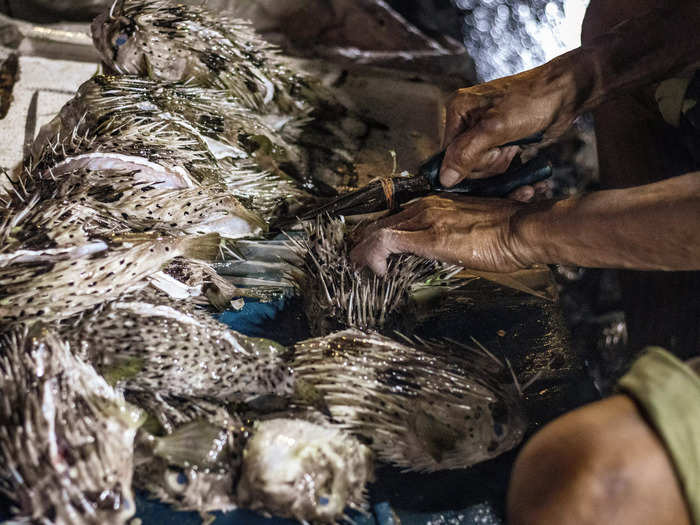
Many people know pufferfish to collectively refer to puffers, but it actually refers to one specific and dangerous type of puffer. In Cebu, puffers are known by two names: "tagutongan" and "butete."
Butete, or balloonfish, is the more widely known type of puffer and can be found in many different sizes. The smallest is just an inch in length, and the largest can expand to over two feet when threatened. Last year, a handful of people died in the Philippines from eating dishes prepared with this type of pufferfish, so locals are wary of both cooking and eating it. Several workers at the market told me they don't catch or sell butete — and that it isn't the puffer that's cooked in local dishes.
In Japan, butete — locally known as "takifugu" — is cooked by licensed chefs despite containing deadly toxins.
On the other hand, tagutongan, or porcupinefish, is known for its long spines and is popular among locals. While both contain the deadly toxin, tagutongan contains 10 times less toxins than pufferfish, Janice Leriorato, a marine biologist at the Cebu-based University of San Carlos, told me.
Leriorato said people don't often get harmed eating porcupinefish, as humans can tolerate lower concentrations of tetrodotoxin.
"Alkaloids, such as morphine, are known for its property to treat pains, and studies have also shown this kind of properties of TTX in lower concentrations," Leriorato said, adding that this is why locals "feel refreshed" when eating porcupinefish and crave it often.
Right outside the market, several small eateries were selling a popular Cebuano dish called "nilarang," which is made with porcupinefish.
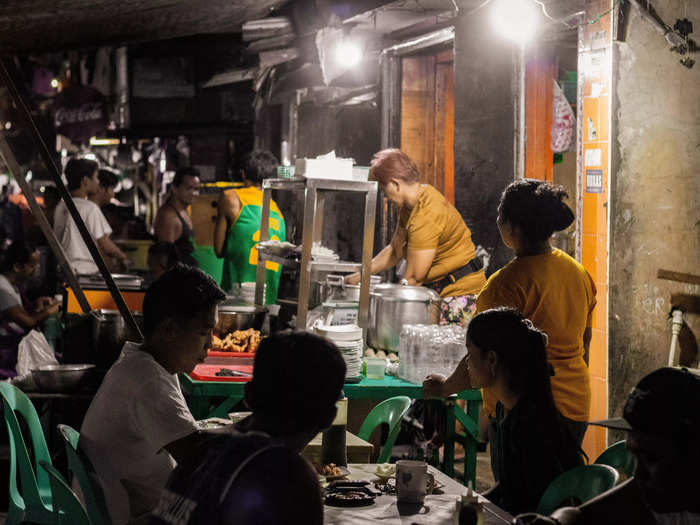
The street where the dish was being sold had a festive vibe.
Dozens of people were sitting on plastic chairs, chatting with friends and enjoying the porcupinefish stew. Fluorescent light bulbs hung above each cart, and local pop songs blared from the speakers.
The street is located right at the entrance of the Pasil informal settlement, the largest of its kind in Cebu. In this area, many people live below the poverty line, which is set at 79 Philippine pesos, or $1.40, per day in the Philippines.
Nilarang is native to central Philippines, specifically the Visayas region, where Cebu is located.
While other meat can be used in nilarang, in Pasil, the most popular meat is tagutongan. It's bought directly from the market and cooked fresh on the spot.
Instead of sitting down for a bowl, we called it a night, as a visit to Dodong's favorite pufferfish spot was already on the next day's itinerary.
The next day, I visited Pasil again. It was a weekday afternoon and buzzing with life.

The streets were filled with tricycles — motorcycles with an attached, covered seat.
Dodong led me to a nearby "karinderya" — a Filipino-style restaurant serving local delicacies in an open-air space — which he declared the best eatery when it comes to porcupinefish.
Shantaya Eatery is a karinderya serving hundreds of plates of nilarang with porcupinefish every day. When I walked in, I found a taxidermied pufferfish hanging overhead.

The family-owned restaurant is housed in a roadside stall with an adjacent dining area. At the time of my visit, it was busy, hot, and overwhelming, with ingredients like seafood and different cuts of pig meat sizzling in several massive woks.
I met Crislee Obatay, a Pasil native and chef who has cooked turtle, eel, and now specializes in porcupinefish, in the middle of a busy lunch service.

Obatay is the owner of Shantaya Eatery. Her sons, Christian, 18, and Clifford, 31, both work at the restaurant and help her prepare the dishes. Her grandma started the karinderya, and it has continued thriving for over 30 years.
"I learned to cook porcupinefish when I was still in my 20s. My grandmother taught me everything I know about cooking," Obatay said in Cebuano. She added that she sells 50 kilograms, or 110 pounds, of porcupinefish every day.
"I feel happy that people enjoy eating it. And policemen, lawyers, and City Hall workers all come here, and they love it," she added.
Linarang na tagutongan is one of the most popular dishes in Pasil. Dozens of people were lining up at Obatay's shop for lunch that day.
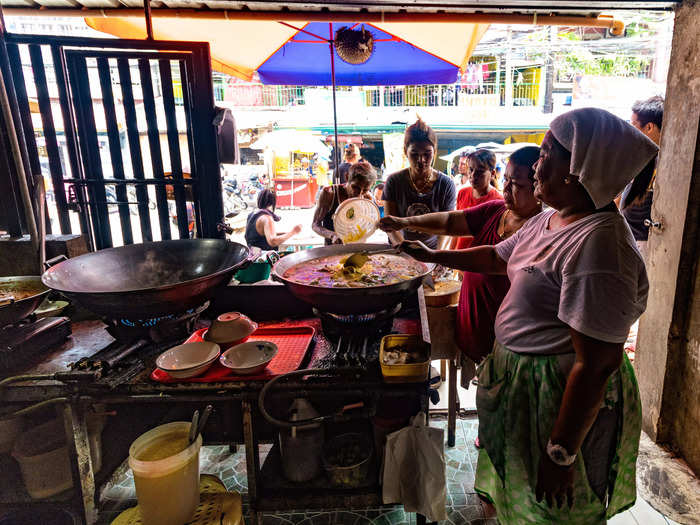
Obatay told me that her diners are from all walks of life — from government workers to local drivers — and that they all come to her karinderya for a taste of her popular dish.
Dodong said he's tried most of the stalls selling porcupinefish stew, but that Obatay's shop is the best — and the one he keeps coming back to.
"Her version is really flavorful, and the porcupinefish is cooked well, so I recommend it," he told me.
Obatay told me she purchases the cleaned tagutongan from the local vendor at the market and then brings it to her stall.
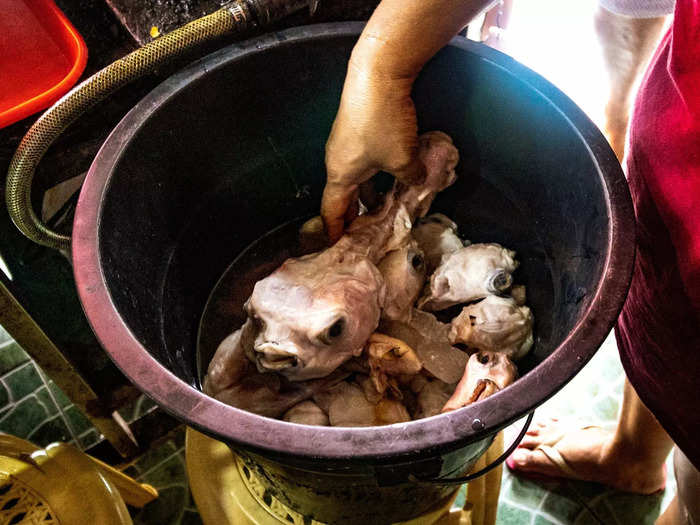
Before sampling the fish myself, I watched Obatay as she prepared all of the ingredients. The porcupinefish's eyes were still intact. It looked even stranger skinned than when I saw it the previous night in the market, but Obatay told me it's a delicacy that's meant to be eaten whole. She said she cooks several buckets of tagutongan every day.
After preparing the stew, I watched her dunk the meat into a simmering liquid.
She explained that porcupinefish liver is one of the most important ingredients in the dish. It's also the part that contains the most toxins.
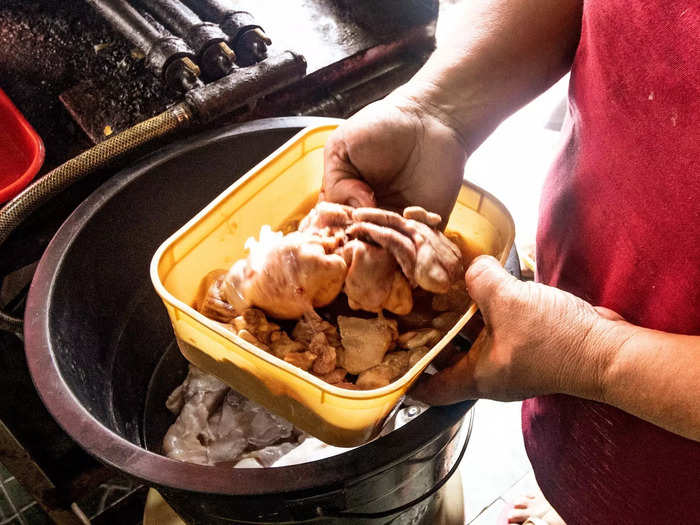
Not all parts of puffer meat contain tetrodotoxin, Leriorato, the marine biologist, told me. She said the toxin is mainly concentrated in the fish eggs and liver.
So imagine my surprise when Obatay brought out a large container filled with raw liver from dozens of porcupinefish.
Leriorato said humans will die instantly if they ingest more than 1.5 milligrams of toxin. Thankfully, the porcupinefish's toxins are at lower concentrations and typically have a therapeutic effect on those who eat it.
"The liver is the most flavorful part," Obatay told me.
"There are many types of puffers but only the ones with small spines are dangerous. The one we serve is safe," she added.
Finally, all the ingredients — including whole porcupinefish and pieces of its liver — were mixed together to form a hearty stew.
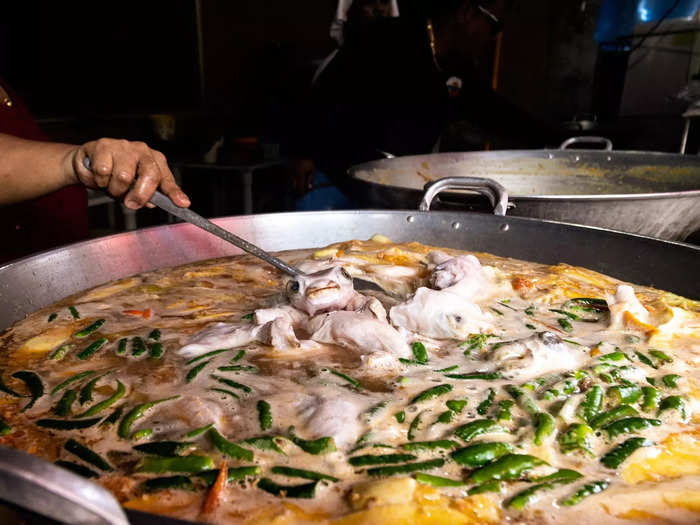
Obatay's version comprises many different vegetables — from onions and tomatoes to green chilis — cooked together in a coconut milk soup.
"I fry the vegetables like onion first, before adding water to boil," Obatay said.
She also used ingredients that are commonly found in tropical countries — like tamarind, a sweet, sour fruit, and green mango — to add flavor to the broth.
In the dining area, Obatay's staff members were rushing ingredients into the kitchen as people continued to pile into the restaurant.
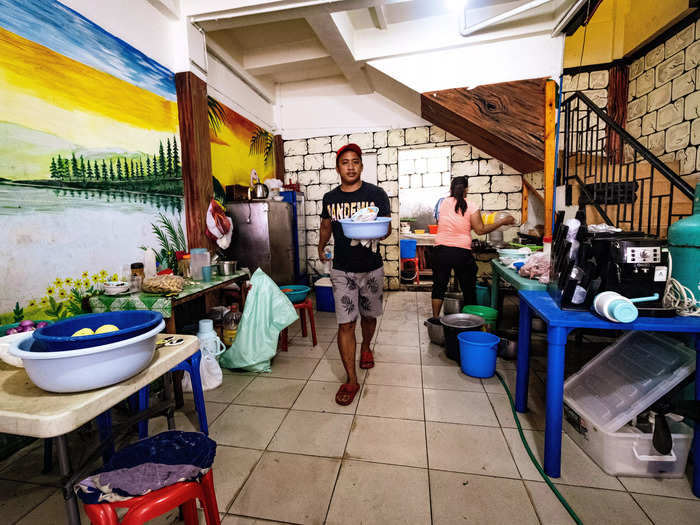
Right outside the prep area were two sets of plastic tables and a handful of stools. At the karinderya, diners eat right by the side of the road, behind dozens of motorcycles.
I spotted one diner who was busy downing Obatay's freshly cooked broth and sucking on the porcupinefish's meat. After he cleared his plate, he asked for another round of the stew. I asked him what the dish tasted like.
"Order one and taste it for yourself. All I can say is it's delicious," he said.
Luckily my dish was already on its way.
So what does porcupinefish taste like? I tried it for myself and as cliché as it sounds, it tasted like chicken.
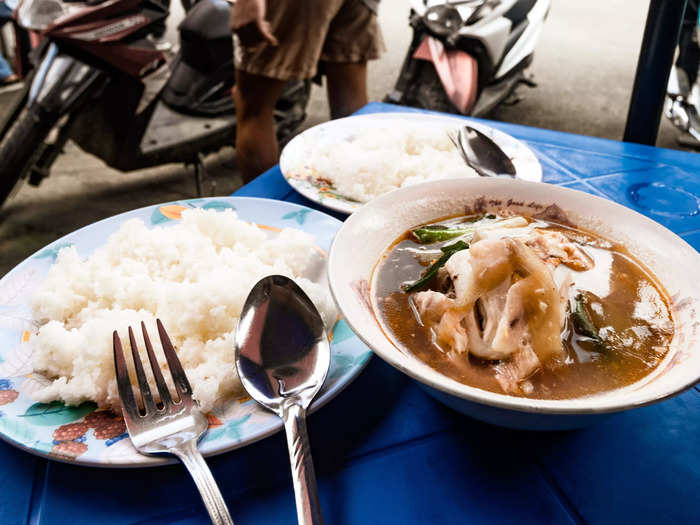
My bowl of stew arrived and was served alongside one plate with rice corn and another with a mound of white rice. The broth, a translucent shade of pale yellow, was slightly oily and contained an entire piece of porcupinefish and a few leafy vegetables.
Dodong recommended that I pair the porcupinefish with rice corn, or what's known as "bugas mais" in Cebuano — a dry, grainy starch made with corn. It's just as popular as rice in Cebu, despite the latter being the most widely eaten carb in the Philippines.
I took a sip of the stew and chased it with a spoonful of porcupinefish meat and corn rice. Surprisingly, it tasted very familiar to me. The dish reminded me of a Filipino dish that I grew up eating: sour stew with meat, or "sinigang" in Tagalog, one of the languages used in the Filipino island of Luzon.
The stew was tangy, sour, and just a tad salty. And the puffer? It tasted pretty ordinary, like a cross between chicken and white fish. Its texture was slightly chewy and more tender than chicken meat. After trying it myself, it became less bizarre or unusual than it had sounded when I arrived. Rather, it's Cebu's version of comfort food — a tasty delicacy everyone should try if they ever visit the island.
Popular Right Now
Advertisement